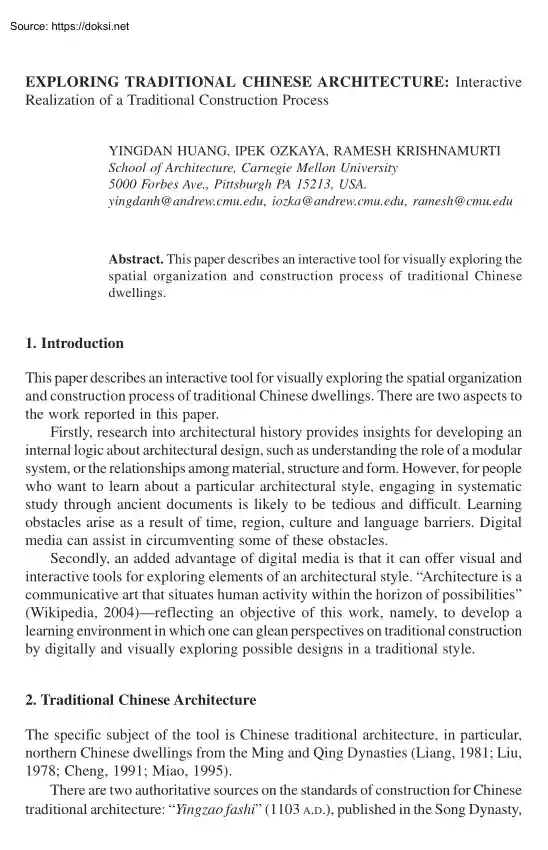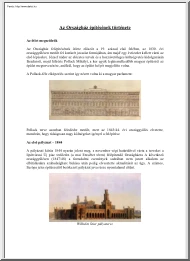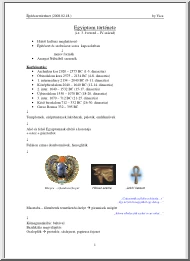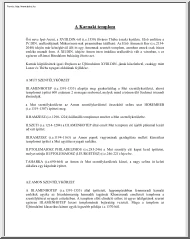Alapadatok
Év, oldalszám:2005, 7 oldal
Nyelv:angol
Letöltések száma:4
Feltöltve:2023. április 18.
Méret:633 KB
Intézmény:
-
Megjegyzés:
Csatolmány:-
Letöltés PDF-ben:Kérlek jelentkezz be!
Értékelések
Nincs még értékelés. Legyél Te az első!
Legnépszerűbb doksik ebben a kategóriában
Tartalmi kivonat
EXPLORING TRADITIONAL CHINESE ARCHITECTURE: Interactive Realization of a Traditional Construction Process YINGDAN HUANG, IPEK OZKAYA, RAMESH KRISHNAMURTI School of Architecture, Carnegie Mellon University 5000 Forbes Ave., Pittsburgh PA 15213, USA yingdanh@andrew.cmuedu, iozka@andrewcmuedu, ramesh@cmuedu Abstract. This paper describes an interactive tool for visually exploring the spatial organization and construction process of traditional Chinese dwellings. 1. Introduction This paper describes an interactive tool for visually exploring the spatial organization and construction process of traditional Chinese dwellings. There are two aspects to the work reported in this paper. Firstly, research into architectural history provides insights for developing an internal logic about architectural design, such as understanding the role of a modular system, or the relationships among material, structure and form. However, for people who want to learn about a particular architectural style,
engaging in systematic study through ancient documents is likely to be tedious and difficult. Learning obstacles arise as a result of time, region, culture and language barriers. Digital media can assist in circumventing some of these obstacles. Secondly, an added advantage of digital media is that it can offer visual and interactive tools for exploring elements of an architectural style. “Architecture is a communicative art that situates human activity within the horizon of possibilities” (Wikipedia, 2004)reflecting an objective of this work, namely, to develop a learning environment in which one can glean perspectives on traditional construction by digitally and visually exploring possible designs in a traditional style. 2. Traditional Chinese Architecture The specific subject of the tool is Chinese traditional architecture, in particular, northern Chinese dwellings from the Ming and Qing Dynasties (Liang, 1981; Liu, 1978; Cheng, 1991; Miao, 1995). There are two authoritative
sources on the standards of construction for Chinese traditional architecture: “Yingzao fashi” (1103 A.D), published in the Song Dynasty, EXPLORING TRADITIONAL CHINESE ARCHITECTURE 103 and “Gongcheng zuofa zeli” (1733 A. D), the Qing government manual on construction regulations. Given the largish number of preserved buildings, Liang’s compilation provides a most useful record of the architecture of Ming and Qing dynasties. For the work reported in this paper, we essentially followed the rules and standards given in his “Qingshi yingzao zeli” (Liang, 1981). It is important to note that northern dwellings abided strictly by the construction regulations. The Chinese traditionally employed three different types of wood framing systems: tai-liang (column-beam-and-strut), chuan-dou (column-and-tie), and jing-gan (ancient Chinese log construction) (Liu, 1978; Chiou and Krishnamurti, 1995). The most representative of these is tai-liang; it is also the most comprehensively
studied (Liang, 1981), and the structural system that we focus on in this paper. 2.1 COMPUTATIONAL RULES FOR DESCRIBING CHINESE TRADITIONAL ARCHITECTURE The Chinese traditionally adopted a modular design approachembodying humanism, economics and technologywhich can all be captured by rules. 2.11Plan Rules The width of a small scale building was typically 3 or 5 jian (bay), which, in Chinese, signifies the classifier for a room. The central space is ming (light), the rooms at both ends are shao (tip) and the rooms in-between are ci(secondary). Possible arrangements are: shao-jian + ming-jian + shao-jian shao-jian + ci-jian + ming-jian + ci-jian + shao-jian The depth of a building is defined by bu-jia: the horizontal distance between the centre lines of two adjacent purlins. Bu means step and jia means frame The maximum depth of traditional dwellings is 7-lin (purlin) including the front and back corridor. Bu can be differentiated by location as lang-bu (corridor step), yanbu (eave
step), jin-bu (golden step), ji-bu (ridge step), and ding-bu (top step) For a given jian and bu-jia, an orthogonal columnar grid (Figure 1) can be determined as well as the dimensions of the base, which plays an important role in the appearance in Chinese traditional architecture. Table 1 defines the variables and relationships between them. 104 YINGDAN HUANG, IPEK OZKAYA, RAMESH KRISHNAMURTI Figure 1. Snapshot from the tool representing a 5 jian, 4 bu-jia 5 lin front corridor style, code snip for axis rules and the columnar grid (comprising 5 purlins + double corridors). TABLE 1. Variables and formulae for the basic module, jian and bu Variables D H W0 W1 W2 Explanation eave column diameter eave column height width of ming-jian width of ci-jian width of shao-jian Variables S0 S1 S2 S3 Module D:H = 1:11 Jian H:W0 = 8:10 or 7:10; W1 = W0 or W1 = 0.8W0 ; W2 = W1 or W2 = 0.8W1 Bu-jia 2D = S0 = 3D ; S1 = S2 = 4D ; S3 = 4D ~ 5D Explanation length of ding-bu length of ji-bu
length of jin-bu length of lang-bu (yan-bu) 2.12 Roof System Rules for roof systems work toward a perfect integration of structure and form. Jujia (the raising-of-truss method of construction) is used to form the curved surface of a roof; it also denotes the vertical distance between the center lines of two adjacent purlins. We consider the juan-peng roof The common rule for a 5-lin building is to multiply lang-bu (yan-bu) by 0.5 and ji-bu by 07 For 6- or 7-lin buildings, the set of scalars for lang-bu, jin-bu and ji-bu are 0.5, 065 and 085 respectively (see Figure 2). EXPLORING TRADITIONAL CHINESE ARCHITECTURE 105 Figure 2. Bu-jia and ju-jia 2.13 Basic construction standards Plan and roof system rules constitute the main part for any rule-based description of traditional Chinese architecture. These rules facilitate computing the dimension and installation for components, and, furthermore, provide the means by which to digitalize traditional construction. The plan rules, the
ju-jia rules depicted in Figure 3, and the dimensioning rules given in Table 2 along with their computation suffice to build the digital tool for the selected exemplarnamely, residential architecture constructed using a tai-liang framing system. Figure 3. Wood framing of 4 bu-jia 5 lin with double corridors (in section and in 3D), code snip for roof rules. 106 YINGDAN HUANG, IPEK OZKAYA, RAMESH KRISHNAMURTI TABLE 2. Dimensioning rules for wood frame components Components Length (L) Beam (5-jia) 4X + 2D Beam (3-jia) 2X + 2D Accessory Beam 4X 1D 0.8D End Beam Y + 2D 1.5D 1.1D Eave Fang W D 0.8D Golden (Ridge) Fang W D – 2C 0.8D – 2C Link Fang Y + 2D D 0.8D Eave Panel W 0.5D + 2C 0.2D Golden/Ridge Panel W 0.5D + 1C 0.2D 1D 1D Golden(Ridge) Post Height (H) H = 1.2T Thickness (T) T =0.8(D + 2C) T = 0.64(D + 2C) Purlin Diameter = D or 0.9D W: Total width of grid 1 Construction Foot in Qing dynasty = 32cm 1 Construction Foot = 10
Construction inches (C) 3. The Tool The tool is set up as an interactive visual learning environment in which users build 3D models using simplified parameterized construction rules in order to explore various types of traditional Chinese dwellings. Figure 4 shows a snapshot from the tool. Figure 4. Snapshot of the tool EXPLORING TRADITIONAL CHINESE ARCHITECTURE 107 3.1 A LEARNING ENVIRONMENT Principles of traditional Chinese architecture constrain design thinking to a certain scope. The architect is free to make decisions within a construction process that follow a prescribed physical sequence. Generally, architects can decide, in advance, on the form or style of some components, while postponing decisions about its dimension or location. This consideration is reflected in the tool, eg, it is possible for a user to choose the form of the roof while its geometric information cannot be decided until the required input of eave column, jian and bu-jia. The formal mode of the tool
is to display the process of the construction sequence with the features of a state machine. With each new decision, the state is changed There are three possible states for components: undecided, half-decided and decided. Once a component is decided, it can be seen in graphically 3D if it is need in the current construction phase, otherwise, it is seen (virtually) in relationship with the construction as a whole. According to Mies van der Rohe, “God is in the detail”. In traditional Chinese architecture, this goes beyond pure decoration. Traditional wood joints make use of tenons, and reflect a successful combination of aesthetics and mechanics. The tool provides the functionality by which users can view a joint from different perspectives. The tool includes interactive 3D models and animation to encourage experimentation and learning. Through an interactively generated model, a building becomes a communicable device rather than a static image for study. By providing the
capability of walking through the building and exposing structural elements, the user can engage with the structure of the entire building (Vassigh, 2002). To make the tool more inviting, we have included elements of game environments such as indicators to show to what extent the construction process has been completed. In this we were inspired by Radford (2000) who stated that: “the essence of ‘games’ lies in a person’s immersion in play subject to rules”. 4. Conclusion The prototype tool is implemented in C++ and OpenGL following an object-oriented software methodology (Flemming, et al., 2002) We employed use case modelling technique for software requirement elicitation (Armour and Miller, 2000). The system design is based on a Model-View-Controller structure (Krasner and Pope, 1988). The model contains the different components of the style as basic objects, such as purlins and columns, reflecting their geometry and spatial relationships to any possible design and
construction within the style. The view encapsulates the graphical user interface for visualization and user input. The controller executes the construction rules. 108 YINGDAN HUANG, IPEK OZKAYA, RAMESH KRISHNAMURTI Possible future directions for this work are to extend the prototype and test it in a classroom environment to observe its performance as an aid for teaching architectural styles, in this case northern Chinese residential dwellings. References Armour, F. & Miller, G 2000, Advanced Use Case Modeling: Software Systems, Addison-Wesley Cheng, Wanli. 1991, Chinese Traditional Architecture, China Architecture and Building Press, Hong Kong Wanli Bookstore. Chiou, S.C & Krishnamurti, R 1995, The Grammatical Basis of Chinese Traditional Architecture, Language of Design, vol. 3, pp 5–31 Flemming, U., Erhan, H & Ozkaya, I 2002, Object-Oriented Application Development in CAD, ACADIA’02, Pomona, pp. 27–38 Li, Andrew I-kang, & Tsou Jin-Yeu. 1995, The
rule-based nature of wood frame construction of the Yingzao fashi and the role of virtual modeling in understanding it, Computing in architectural research, Proceedings of the International Conference on Chinese Architectural History, Hong Kong, pp. 25–40 Liang, Sicheng. 1981, Qingshi Yingzao Zeli (Architectural Methods of the Qing Dynasty), China Architecture and Building Press. Liu, Dunzhen. 1978, Chinese Ancient Architectural History, China Architecture and Building Press Krasner, G. & Pope, S 1988, A Cookbook for Using the Model-View-Controller User Interface Paradigm in Smalltalk-80. The Journal of Object-Oriented Programming (JOOP), August/ September. Miao, Guanfeng. 1995, Qing Xiao Shi Jian Zhu, Beijing University of Technology Press, Beijing Radford, A.D 2000, Games and Learning about Form in Architecture, Automation in Construction, vol. 9, pp 379–385 Vassigh, Shahin. 2002, Learning in Digital Space: Dynamic Visualization of Structural Behavior as Teaching Strategy,
ACADIA’02, Pomona, pp. 39–47 Wikipedia. 2004, Category: Architecture, http://enwikipediaorg/wiki/Category: Architecture Last visited January 26, 2004
engaging in systematic study through ancient documents is likely to be tedious and difficult. Learning obstacles arise as a result of time, region, culture and language barriers. Digital media can assist in circumventing some of these obstacles. Secondly, an added advantage of digital media is that it can offer visual and interactive tools for exploring elements of an architectural style. “Architecture is a communicative art that situates human activity within the horizon of possibilities” (Wikipedia, 2004)reflecting an objective of this work, namely, to develop a learning environment in which one can glean perspectives on traditional construction by digitally and visually exploring possible designs in a traditional style. 2. Traditional Chinese Architecture The specific subject of the tool is Chinese traditional architecture, in particular, northern Chinese dwellings from the Ming and Qing Dynasties (Liang, 1981; Liu, 1978; Cheng, 1991; Miao, 1995). There are two authoritative
sources on the standards of construction for Chinese traditional architecture: “Yingzao fashi” (1103 A.D), published in the Song Dynasty, EXPLORING TRADITIONAL CHINESE ARCHITECTURE 103 and “Gongcheng zuofa zeli” (1733 A. D), the Qing government manual on construction regulations. Given the largish number of preserved buildings, Liang’s compilation provides a most useful record of the architecture of Ming and Qing dynasties. For the work reported in this paper, we essentially followed the rules and standards given in his “Qingshi yingzao zeli” (Liang, 1981). It is important to note that northern dwellings abided strictly by the construction regulations. The Chinese traditionally employed three different types of wood framing systems: tai-liang (column-beam-and-strut), chuan-dou (column-and-tie), and jing-gan (ancient Chinese log construction) (Liu, 1978; Chiou and Krishnamurti, 1995). The most representative of these is tai-liang; it is also the most comprehensively
studied (Liang, 1981), and the structural system that we focus on in this paper. 2.1 COMPUTATIONAL RULES FOR DESCRIBING CHINESE TRADITIONAL ARCHITECTURE The Chinese traditionally adopted a modular design approachembodying humanism, economics and technologywhich can all be captured by rules. 2.11Plan Rules The width of a small scale building was typically 3 or 5 jian (bay), which, in Chinese, signifies the classifier for a room. The central space is ming (light), the rooms at both ends are shao (tip) and the rooms in-between are ci(secondary). Possible arrangements are: shao-jian + ming-jian + shao-jian shao-jian + ci-jian + ming-jian + ci-jian + shao-jian The depth of a building is defined by bu-jia: the horizontal distance between the centre lines of two adjacent purlins. Bu means step and jia means frame The maximum depth of traditional dwellings is 7-lin (purlin) including the front and back corridor. Bu can be differentiated by location as lang-bu (corridor step), yanbu (eave
step), jin-bu (golden step), ji-bu (ridge step), and ding-bu (top step) For a given jian and bu-jia, an orthogonal columnar grid (Figure 1) can be determined as well as the dimensions of the base, which plays an important role in the appearance in Chinese traditional architecture. Table 1 defines the variables and relationships between them. 104 YINGDAN HUANG, IPEK OZKAYA, RAMESH KRISHNAMURTI Figure 1. Snapshot from the tool representing a 5 jian, 4 bu-jia 5 lin front corridor style, code snip for axis rules and the columnar grid (comprising 5 purlins + double corridors). TABLE 1. Variables and formulae for the basic module, jian and bu Variables D H W0 W1 W2 Explanation eave column diameter eave column height width of ming-jian width of ci-jian width of shao-jian Variables S0 S1 S2 S3 Module D:H = 1:11 Jian H:W0 = 8:10 or 7:10; W1 = W0 or W1 = 0.8W0 ; W2 = W1 or W2 = 0.8W1 Bu-jia 2D = S0 = 3D ; S1 = S2 = 4D ; S3 = 4D ~ 5D Explanation length of ding-bu length of ji-bu
length of jin-bu length of lang-bu (yan-bu) 2.12 Roof System Rules for roof systems work toward a perfect integration of structure and form. Jujia (the raising-of-truss method of construction) is used to form the curved surface of a roof; it also denotes the vertical distance between the center lines of two adjacent purlins. We consider the juan-peng roof The common rule for a 5-lin building is to multiply lang-bu (yan-bu) by 0.5 and ji-bu by 07 For 6- or 7-lin buildings, the set of scalars for lang-bu, jin-bu and ji-bu are 0.5, 065 and 085 respectively (see Figure 2). EXPLORING TRADITIONAL CHINESE ARCHITECTURE 105 Figure 2. Bu-jia and ju-jia 2.13 Basic construction standards Plan and roof system rules constitute the main part for any rule-based description of traditional Chinese architecture. These rules facilitate computing the dimension and installation for components, and, furthermore, provide the means by which to digitalize traditional construction. The plan rules, the
ju-jia rules depicted in Figure 3, and the dimensioning rules given in Table 2 along with their computation suffice to build the digital tool for the selected exemplarnamely, residential architecture constructed using a tai-liang framing system. Figure 3. Wood framing of 4 bu-jia 5 lin with double corridors (in section and in 3D), code snip for roof rules. 106 YINGDAN HUANG, IPEK OZKAYA, RAMESH KRISHNAMURTI TABLE 2. Dimensioning rules for wood frame components Components Length (L) Beam (5-jia) 4X + 2D Beam (3-jia) 2X + 2D Accessory Beam 4X 1D 0.8D End Beam Y + 2D 1.5D 1.1D Eave Fang W D 0.8D Golden (Ridge) Fang W D – 2C 0.8D – 2C Link Fang Y + 2D D 0.8D Eave Panel W 0.5D + 2C 0.2D Golden/Ridge Panel W 0.5D + 1C 0.2D 1D 1D Golden(Ridge) Post Height (H) H = 1.2T Thickness (T) T =0.8(D + 2C) T = 0.64(D + 2C) Purlin Diameter = D or 0.9D W: Total width of grid 1 Construction Foot in Qing dynasty = 32cm 1 Construction Foot = 10
Construction inches (C) 3. The Tool The tool is set up as an interactive visual learning environment in which users build 3D models using simplified parameterized construction rules in order to explore various types of traditional Chinese dwellings. Figure 4 shows a snapshot from the tool. Figure 4. Snapshot of the tool EXPLORING TRADITIONAL CHINESE ARCHITECTURE 107 3.1 A LEARNING ENVIRONMENT Principles of traditional Chinese architecture constrain design thinking to a certain scope. The architect is free to make decisions within a construction process that follow a prescribed physical sequence. Generally, architects can decide, in advance, on the form or style of some components, while postponing decisions about its dimension or location. This consideration is reflected in the tool, eg, it is possible for a user to choose the form of the roof while its geometric information cannot be decided until the required input of eave column, jian and bu-jia. The formal mode of the tool
is to display the process of the construction sequence with the features of a state machine. With each new decision, the state is changed There are three possible states for components: undecided, half-decided and decided. Once a component is decided, it can be seen in graphically 3D if it is need in the current construction phase, otherwise, it is seen (virtually) in relationship with the construction as a whole. According to Mies van der Rohe, “God is in the detail”. In traditional Chinese architecture, this goes beyond pure decoration. Traditional wood joints make use of tenons, and reflect a successful combination of aesthetics and mechanics. The tool provides the functionality by which users can view a joint from different perspectives. The tool includes interactive 3D models and animation to encourage experimentation and learning. Through an interactively generated model, a building becomes a communicable device rather than a static image for study. By providing the
capability of walking through the building and exposing structural elements, the user can engage with the structure of the entire building (Vassigh, 2002). To make the tool more inviting, we have included elements of game environments such as indicators to show to what extent the construction process has been completed. In this we were inspired by Radford (2000) who stated that: “the essence of ‘games’ lies in a person’s immersion in play subject to rules”. 4. Conclusion The prototype tool is implemented in C++ and OpenGL following an object-oriented software methodology (Flemming, et al., 2002) We employed use case modelling technique for software requirement elicitation (Armour and Miller, 2000). The system design is based on a Model-View-Controller structure (Krasner and Pope, 1988). The model contains the different components of the style as basic objects, such as purlins and columns, reflecting their geometry and spatial relationships to any possible design and
construction within the style. The view encapsulates the graphical user interface for visualization and user input. The controller executes the construction rules. 108 YINGDAN HUANG, IPEK OZKAYA, RAMESH KRISHNAMURTI Possible future directions for this work are to extend the prototype and test it in a classroom environment to observe its performance as an aid for teaching architectural styles, in this case northern Chinese residential dwellings. References Armour, F. & Miller, G 2000, Advanced Use Case Modeling: Software Systems, Addison-Wesley Cheng, Wanli. 1991, Chinese Traditional Architecture, China Architecture and Building Press, Hong Kong Wanli Bookstore. Chiou, S.C & Krishnamurti, R 1995, The Grammatical Basis of Chinese Traditional Architecture, Language of Design, vol. 3, pp 5–31 Flemming, U., Erhan, H & Ozkaya, I 2002, Object-Oriented Application Development in CAD, ACADIA’02, Pomona, pp. 27–38 Li, Andrew I-kang, & Tsou Jin-Yeu. 1995, The
rule-based nature of wood frame construction of the Yingzao fashi and the role of virtual modeling in understanding it, Computing in architectural research, Proceedings of the International Conference on Chinese Architectural History, Hong Kong, pp. 25–40 Liang, Sicheng. 1981, Qingshi Yingzao Zeli (Architectural Methods of the Qing Dynasty), China Architecture and Building Press. Liu, Dunzhen. 1978, Chinese Ancient Architectural History, China Architecture and Building Press Krasner, G. & Pope, S 1988, A Cookbook for Using the Model-View-Controller User Interface Paradigm in Smalltalk-80. The Journal of Object-Oriented Programming (JOOP), August/ September. Miao, Guanfeng. 1995, Qing Xiao Shi Jian Zhu, Beijing University of Technology Press, Beijing Radford, A.D 2000, Games and Learning about Form in Architecture, Automation in Construction, vol. 9, pp 379–385 Vassigh, Shahin. 2002, Learning in Digital Space: Dynamic Visualization of Structural Behavior as Teaching Strategy,
ACADIA’02, Pomona, pp. 39–47 Wikipedia. 2004, Category: Architecture, http://enwikipediaorg/wiki/Category: Architecture Last visited January 26, 2004





